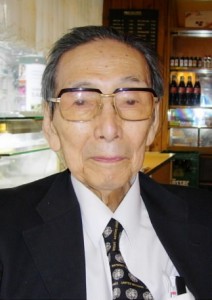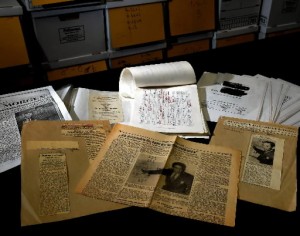Documents and photos tell how Japanese physicist conveyed information on the dangers of radiation damage in Europe
Nov. 6, 2015
by Kyosuke Mizukawa, Staff Writer
Materials connected to the life and work of Yasushi Nishiwaki, who played an important role in the spread of knowledge concerning radiation-related damage, are newly available to researchers. Dr. Nishiwaki (1917-2011), a physicist, examined the “ashes of death” that fell following a hydrogen bomb test conducted by the United States in March 1954. The radioactive fallout dusted a Japanese fishing boat called the Daigo Fukuryu Maru (The Lucky Dragon No. 5), exposing the members of its crew to radiation. Shortly after the incident, Dr. Nishiwaki traveled to Europe to report on the damage and call for a ban on nuclear and hydrogen bombs. The materials include newspaper articles and photos concerning his speaking engagements in Europe. Researchers are interested in these valuable documents which tell how he swiftly conveyed to the world information on the harm to human health caused by the hydrogen bomb test and helped sway international opinion toward banning nuclear tests.
At the time, Dr. Nishiwaki was an associate professor at Osaka City Medical College (today’s Osaka City University). From newspaper articles, it has been confirmed that he visited more than 20 places, including universities and research institutions, in the United Kingdom, France, and eight other European nations between July and November 1954. An article that appeared in a West German newspaper issued on October 1, 1954 was headlined: “Atomic bombs pose a threat to human life.” Among the materials are notes for a lecture that include the words, “There is no knowing how much harm will be caused by eating fish that has been contaminated by the radioactive fallout.”
Some of the several hundred photos taken in Europe show Dr. Nishiwaki explaining how researchers at the University of Tokyo and other institutions detected uranium 237 from samples of the fallout. Uranium 237 provided a basis for the late Joseph Rotblat, a British physicist, to determine that the bomb tested at Bikini Atoll was a “dirty bomb.” Such weapons release a massive amount of radioactive substances in three stages: nuclear fission, nuclear fusion, and additional nuclear fission.
Dr. Nishiwaki’s reports also galvanized international public opinion against nuclear weapons and led to the establishment of the Pugwash Conferences in 1957, a global organization of scientists who seek the elimination of nuclear weapons.
Other materials include English explanations on the health damage caused by radiation from the Hiroshima atomic bombing. It is believed that Dr. Nishiwaki used these explanations when he gave lectures at the University of Vienna, where he started teaching in the 1970s. Members of Dr. Nishiwaki’s family sent more than 1,000 items in about 80 cardboard boxes to researchers including Masakatsu Yamazaki, a professor emeritus at the Tokyo Institute of Technology. The researchers will examine the materials, which will be kept at the institute and made accessible to the public. Their aim is to draw up a list of the items by March of next year, which is the end of the current academic year.
Dr. Yamazaki has used these materials to write a paper on Dr. Nishiwaki. He will offer copies of this paper to the participants at the 61st Pugwash International Conference, which will open in Nagasaki on November 1.
(Originally published on October 29, 2015)
Materials connected to the life and work of Yasushi Nishiwaki, who played an important role in the spread of knowledge concerning radiation-related damage, are newly available to researchers. Dr. Nishiwaki (1917-2011), a physicist, examined the “ashes of death” that fell following a hydrogen bomb test conducted by the United States in March 1954. The radioactive fallout dusted a Japanese fishing boat called the Daigo Fukuryu Maru (The Lucky Dragon No. 5), exposing the members of its crew to radiation. Shortly after the incident, Dr. Nishiwaki traveled to Europe to report on the damage and call for a ban on nuclear and hydrogen bombs. The materials include newspaper articles and photos concerning his speaking engagements in Europe. Researchers are interested in these valuable documents which tell how he swiftly conveyed to the world information on the harm to human health caused by the hydrogen bomb test and helped sway international opinion toward banning nuclear tests.
At the time, Dr. Nishiwaki was an associate professor at Osaka City Medical College (today’s Osaka City University). From newspaper articles, it has been confirmed that he visited more than 20 places, including universities and research institutions, in the United Kingdom, France, and eight other European nations between July and November 1954. An article that appeared in a West German newspaper issued on October 1, 1954 was headlined: “Atomic bombs pose a threat to human life.” Among the materials are notes for a lecture that include the words, “There is no knowing how much harm will be caused by eating fish that has been contaminated by the radioactive fallout.”
Some of the several hundred photos taken in Europe show Dr. Nishiwaki explaining how researchers at the University of Tokyo and other institutions detected uranium 237 from samples of the fallout. Uranium 237 provided a basis for the late Joseph Rotblat, a British physicist, to determine that the bomb tested at Bikini Atoll was a “dirty bomb.” Such weapons release a massive amount of radioactive substances in three stages: nuclear fission, nuclear fusion, and additional nuclear fission.
Dr. Nishiwaki’s reports also galvanized international public opinion against nuclear weapons and led to the establishment of the Pugwash Conferences in 1957, a global organization of scientists who seek the elimination of nuclear weapons.
Other materials include English explanations on the health damage caused by radiation from the Hiroshima atomic bombing. It is believed that Dr. Nishiwaki used these explanations when he gave lectures at the University of Vienna, where he started teaching in the 1970s. Members of Dr. Nishiwaki’s family sent more than 1,000 items in about 80 cardboard boxes to researchers including Masakatsu Yamazaki, a professor emeritus at the Tokyo Institute of Technology. The researchers will examine the materials, which will be kept at the institute and made accessible to the public. Their aim is to draw up a list of the items by March of next year, which is the end of the current academic year.
Dr. Yamazaki has used these materials to write a paper on Dr. Nishiwaki. He will offer copies of this paper to the participants at the 61st Pugwash International Conference, which will open in Nagasaki on November 1.
(Originally published on October 29, 2015)









